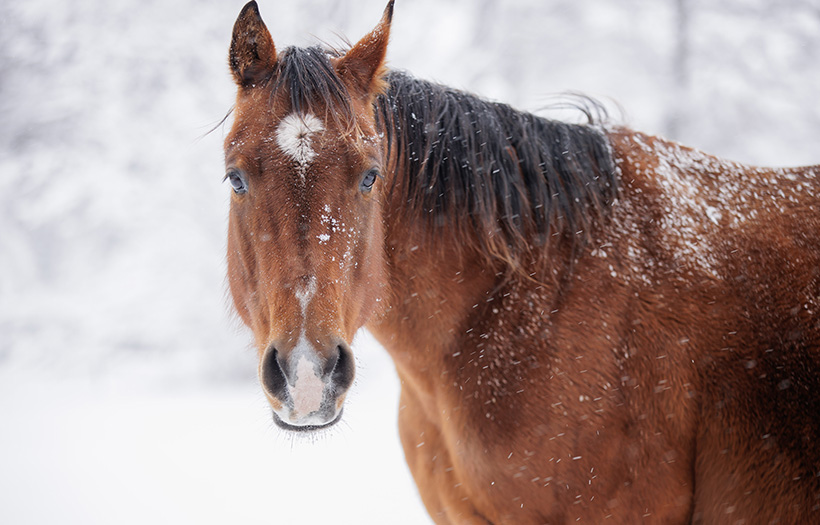Overweight Horses: Winter Management

Feeding the overweight horse can be tough, but winter poses an even greater challenge with managing a delicate balance between providing enough energy to stay warm, yet not so much he is unable to shed those unwanted pounds.
When considering the feeding program for your overweight horse, first take into consideration the forage type, quantity and frequency he is being fed. The overweight horse benefits most from grass hay over legume hay due to it’s reduced calorie content. Most overweight horses do best on grass hay with a ration balancer to provide balanced levels of necessary vitamins, minerals and amino acids.
Consider how frequently he has access to his forage. Is he limit fed or allowed free access anytime of the day or night? Generally speaking, limit feeding the overweight horse is one half of a critical equation to helping him shed those pounds. Forage should make up the bulk of any horse’s ration and the overweight horse is no exception. His forage ration should be between 1.0-1.75 lb. hay per 100 lb. body weight, per day. For a 1,000 lb. horse, this would range from 10-17.5 lb. of hay each day.
Next, consider his living arrangement: Is he kept by himself or does he share feed with herd-members? If possible, put him in isolation from other members of the herd to help control his intake. Overweight horses may be considered ‘survivors’ in the wild as they oftentimes bully their way into their herd-member’s food supply, but as domesticated animals, they need not exhibit this behavior when a consistent, good quality supply of food is provided. Isolating him from those he can bully will keep his portion size to what you fed him.
Next, take into consideration how he is managed: Is he kept in a stall, coat clipped in a heated barn? Is he turned out on a regular basis? Does he live outside with access to a run-in or loafing shed? How he is managed can play into how to help him lose weight, yet stay warm during the oftentimes brutal winter months. Horses that are most frequently stalled benefit from turnout, safe footing permitted. Those turned out full-time should be monitored for the need of a blanket should weather conditions deteriorate enough to warrant; moisture penetrating the thick winter coat as well as a biting winter wind can cut through the toughest of their protections.
Finally, consider his activity level. Winter in most parts of the United States bring snow, ice and/or frozen footing which can pose a challenge for horse owners. Good footing is essential for reducing the occurrence of injury during exercise and this is no less important than in the winter months. Here are a few suggestions for exercising your overweight horse when the footing is less than ideal.
- Hand walking – up or down the driveway, on a trail or around an arena is good for him and a great time to bond.
- Pasture turnout – solid footing permitting, turn him out for time to romp in the snow and work off some energy.
- Time on the lunge line – provides better control over his activity level than turnout and he can work faster than a hand walk.
- Trailer to a near-by indoor arena (if there is one close by) for lunge-work, saddle time or just some quiet hand walking.
Helping your overweight horse lose during the winter can be a delicate balance, but with some effort and creativity he can start out the New Year on the way to being a trimmer, healthier horse.
